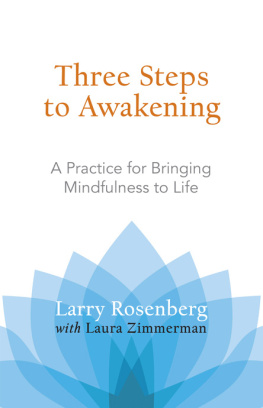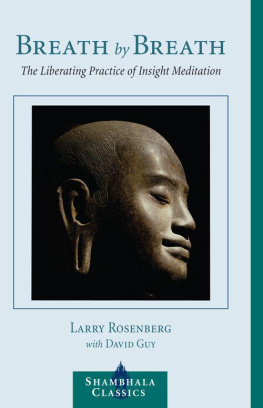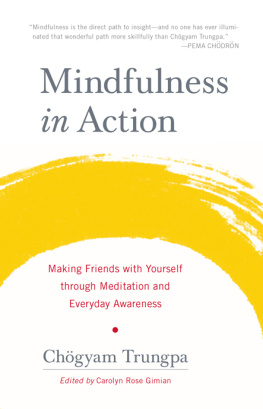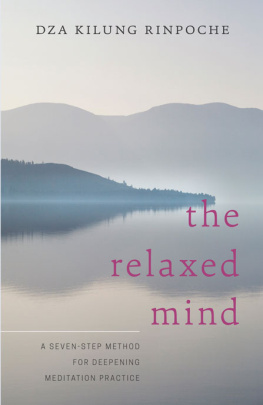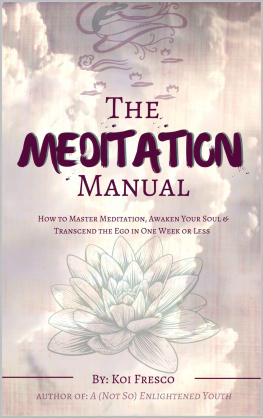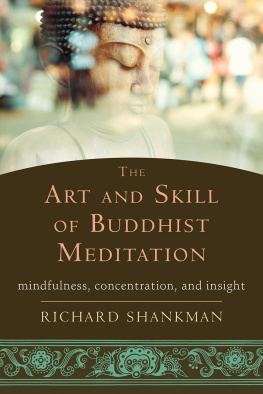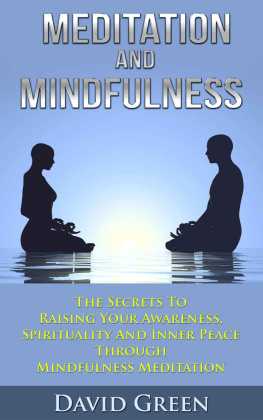For those who seek clear, wise guidance in the how tos of Buddhist meditation, Larry Rosenbergs new book will become a valued resource. Written with great simplicity, intelligence and warmth, Three Steps to Awakening introduces core practices that together constitute a vibrantly alive spiritual path.
Tara Brach, PhD, author of Radical Acceptance and True Refuge
Larry Rosenberg offers us a practice that, although based on the Anapanasati Sutta of the Buddha, is honed from his own realization and thus holds the pragmatism of his decades of meditation and teaching. He does not stop with formal instructions but encourages us forward beyond special forms and environment and drops us off at the gateway of our lives. Larry calls himself a minimalist, and it is because he gives us only what is relevant so that we can move easily with his teaching toward the liberation of our own minds and hearts.
Rodney Smith, author of Stepping Out of Self-Deception: The Buddhas Liberating Teaching of No-Self and Awakening: A Paradigm Shift of the Heart
ABOUT THE BOOK
This book represents the distillation of Larry Rosenbergs more than forty years of teaching. Drawing on the various Buddhist traditions in which he has practiced, he describes three subtly different but complementary forms of meditation practice: (1) breath awareness, (2) breath as anchor, and (3) choiceless awareness.
Having the three methods in ones repertoire gives one meditation resources for any life situation. In a time of stress, for example, one might use breath awareness exclusively. Or on an extended retreat, one might find choiceless awareness more appropriate. The three-step method has been taught to Larrys students at the Cambridge Meditation Center in Cambridge, Massachusetts, for many years.
After teaching the three-step method, Larry goes on to show how to bring the awareness gained in meditation to the world off the cushion, into relationships and into all areas of daily life.
LARRY ROSENBERG is founder and resident teacher of the Cambridge Insight Meditation Center in Cambridge, Massachusetts, and a guiding teacher at the Insight Meditation Society in Barre, Massachusetts.
Sign up to learn more about our books and receive special offers from Shambhala Publications.

Or visit us online to sign up at shambhala.com/eshambhala.
Three Steps to Awakening

A Practice for BringingMindfulness to Life
LARRY ROSENBERG
With Laura Zimmerman

SHAMBHALA
Boston & London
2013
Shambhala Publications, Inc.
Horticultural Hall
300 Massachusetts Avenue
Boston, Massachusetts 02115
www.shambhala.com
2013 by Larry Rosenberg
Cover design by Jim Zaccaria
Interview with Krishnamurti copyright by Madeline Drexler.
Reprinted with permission.
Li Po, Zazen on Ching-ting Mountain from Crossing the Yellow River: Three Hundred Poems from the Chinese, translated by Sam Hamill. Copyright 2000 by Sam Hamill. Reprinted with the permission of The Permissions Company, Inc., on behalf of Tiger Bark Press, www.tigerbarkpress.com.
All rights reserved. No part of this book may be reproduced in any form or by any means, electronic or mechanical, including photocopying, recording, or by any information storage and retrieval system, without permission in writing from the publisher.
Library of Congress Cataloging-in-Publication Data
Rosenberg, Larry.
Three steps to awakening: a practice for bringing mindfulness to life / Larry Rosenberg with Laura Zimmerman.First edition.
pages cm
eISBN 978-0-8348-2920-6
ISBN 978-1-59030-516-4 (pbk.)
1. MeditationBuddhism. I. Zimmerman, Laura. II. Title.
BQ5612.R67 2013
294.34435dc23
2013008214
To Mr. J. Krishnamurti.
Even years after his death, the profound impact of J. Krishnamurti and his beautiful teachings on my life as expressed in this book is evident. His unrelenting emphasis on what is remains with me to this day.
Beneficial beyond words!
Thank you, Krishnaji.
From the age of six I had a mania for drawing the form of things. By the time I was fifty I had published an infinity of designs. But all I have produced before the age of seventy is not worth taking into account. At seventy-three, I have learned a little about the real structure of nature, of animals, plants, trees, birds, fishes and insects. In consequence, when I am eighty, I shall have made still more progress. At ninety I shall penetrate the mystery of things; at one hundred I shall certainly have reached a marvelous stage; and when I am one hundred and ten, everything I do, be it a dot or a line, will be alive. I beg those who live as long as I to see if I do not keep my word.
WRITTEN AT THE AGE OF SEVENTY-FIVE BY ME, ONCE HOKUSAI, TODAY GWAKYO ROJIN, THE OLD MAN MAD ABOUT DRAWING (1835)
Contents
When Krishnamurti died in 1986, I inquired as to who really got his teachings. The name of a woman named Vimala Thakar, living in Mount Abu, India came up, again and again. After many exchanges of mail, she accepted my invitation to come to Cambridge and share her immense depth of understanding with all of us. She did that for a number of years before retiring to her home in India. We maintained a correspondence until her death. My original intent was to dedicate this book to her, as well as Krishnamurti, but in her last letter before death, she was firm in declining such an offer. Her writings and many personal exchanges enriched my life and remain a source of inspiration to this day.
Jon Kabat-Zinn has been my dear friend, confidante, and fellow yogi for almost fifty years. Our countless discussions clearly have helped shape these teachings.
Matthew Daniell and Doug Phillips started out as devoted students, and are now close friends and fellow teachers. Our ongoing and intense conversations on Vipassana meditation have enriched my practice and teachings beyond what they can imagine.
Thanissaro Bhikkhus writing and teaching gives us all the opportunity to share in his wealth of understanding of the Buddhas teaching on the liberating power of mindful breathing. We have had many exchanges on this subject over the years. His careful reading and suggestions about this material were immensely beneficial. We have strong disagreements on many points, but these seem to enrich rather than interfere with our friendship.
Jacalyn Bennett, a cherished friend and student for so many years, constantly urged me, with loving words and financial support, to bring this book to completion. Her encouragement was crucial!
Dennis Humphreys, for many years a devoted student and friend, constantly scolded and badgered mealways with affection and humorto put what I was teaching into a useful form. Here it is.
Thank you to all the countless yogis at the Cambridge Insight Meditation Center for their questions and reports on meditation practice, and also for transcribing the huge volume of Dharma talks, which provided us with the raw material for this publication.
Joe Shays generosity was an enormous help every step along the way.
Dave ONeal. What can I say? This soft-spoken, understated, brilliant gentleman for the third time has informed me that there was really a useful book buried in a mountain of verbiage, and then proceeded to clearly inform me what to do about it. All done with a light touch and humor.
Next page
